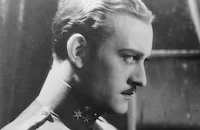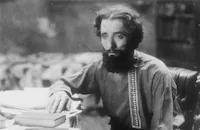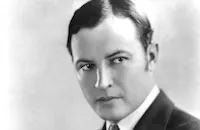The Mad Empress
Cast & Crew
Miguel C. Torres
Medea Novora
Conrad Nagel
Guy Bates Post
Evelyn Brent
Claudia Dell
Film Details
Technical Specs

Synopsis
In Paris, in 1862, French Emperor Louis Napoleon III offers the throne of Mexico to Archduke Maximilian and his wife, Princess Carlotta of Belgium. Prince Metternick advises against accepting the offer because there is so little support for the French empire in Mexico, especially on the part of the United States. Maximilian, whose brother is Francis Joseph, the emperor of Austria, is reluctant to accept the Mexican throne because to do so he must renounce his claim to the Austrian throne, but Carlotta convinces him that this is an opportunity to build a new Hapsburgh empire. When Maximilian and Carlotta arrive in Mexico, they learn that former Mexican president Benito Juarez is still fighting for the Republic and has the support of the majority of the Mexican people. Hoping to ingratiate themselves to the Mexicans, Maximilian and Carlotta adopt a child from the Itirbes, Mexico's royal family, after their advisors suggest that an heir would consolidate their position. Through bad management, the imperial treasury is bankrupt. At the same time, United States President Abraham Lincoln conveys his disapproval of the Mexican empire to France. After General Bazaine convinces Maximilian to sign an anti-guerilla decree allowing unauthorized military personal to be killed, a move which angers the Mexicans, Napoleon recalls the French troops. Despite their troubles, Maximilian and Carlotta refuse to abdicate and leave the country. Carlotta decides to travel to Europe and beg Napoleon and the pope for support. After her mission fails, Carlotta becomes insane and remains in Europe. Maximilian wants to abdicate and join her, but his advisors convince him to remain in Mexico. As Juarez's troops advance, Maximilian takes refuge in the monastery at Queretaro, where he is captured and condemned to death. Juarez refuses to pardon Maximilian and he dies thinking of Carlotta.

Director
Miguel C. Torres
Cast
Medea Novora

Conrad Nagel
Guy Bates Post

Evelyn Brent

Claudia Dell
Frank Mcglynn Sr.
Gustave Von Seyffertitz

Nigel De Brulier
Michael Visaroff
Earl Gunn
George Regas
Rudolph Amendt

Robert Frazier
Duncan Renaldo
Graciela Romero
Julian Rivero
Rolfe Sedan
Franklin Murrell

Martin Garralaga
Rina De Liguoro
Marin Sais
Edgar Norton
Charles Bobbett
Kurt Von Fuerberg
Crew
Lionel Atwill
Jean Bart
James [c.] Bradford
C. Cabello
Bartlett Carré
P. Castelain
J. Centeno
Jerome Chodorov
M. Delgado
Arthur Martinelli
Doc Merman
A. Esparza Oteo
Alex Phillips
Carl Pierson
Farrell Redd
F. Paul Sylos
Mario Talavera
Miguel C. Torres
Miguel C. Torres
Miguel C. Torres
Miguel C. Torres

Film Details
Technical Specs

Quotes
Trivia
Notes
The working titles of this film were Maximilian and Carlotta, Juarez and Maximilian and Maximilian. It was also reviewed as Maximilian and Carlotta and Juarez and Maximilian. An introduction to the beginning of the film reads, "Through the courtesy of the Mexican government some of the important scenes in this picture-the Cathedral, the National Palace, the Empress' bedroom, the Castle and the grounds of Chapultepec, and Queretaro-were taken in authentic places where the drama of Maximilian and Carlotta actually evolved." According to materials contained in the file on the film in the MPAA/PCA Collection at the AMPAS Library, Miguel C. Torres filmed another version of this film in 1935 entitled Juarez and Maximilian. The film was in Spanish, also starred Medea Novaro, Torres' wife, and featured a Spanish-speaking cast. It was shot in Mexico City under the informal sponsorship of the Mexican government. The picture featured Mexican cavalry troops as extras in the battle scenes. Torres also persuaded the Mexican government to tear down hundreds of telephone poles along the way to the National Palace to allow his cameras to shoot Maximilian's entrance to the city. Torres used these sequences in The Mad Empress.
Sources conflict about the production company of the film. The Motion Picture Herald review lists Miguel C. Torres as the production company, whereas a news item in Hollywood Reporter lists Colonial Pictures. According to a news item in Daily Variety, Torres was forced to suspend production in February 1938 because of a lack of funds. When Torres stopped shooting, he was $18,000 in debt. On February 18, 1939, the picture went back into production at Talisman Studios in California, with additional funding provided by Warner Bros. Materials contained in the Warner Bros. files at the USC Cinema-Television Library elucidate on details of how Torres got Warner Bros. to fund him. When Torres started production on this film, Warner Bros. informed him that they owned all motion picture and collateral rights to the Franz Werfel play based on the life of Maximilian and Carlotta, and asked him to refrain from using the title Juarez and Maximilian. After Torres ran out of money to finish his picture, he approached Harry Cohn of Columbia Pictures about distributing the film. To end the threat of another company distributing Torres' film before Warner Bros. could release their film, Juarez, Warner Bros. gave him the money to finish his production on the condition that they control distribution. Once it was completed, Warner Bros. cut the film from 95 to 72 minutes and released it under the title The Mad Empress. The Warner Bros. film Juarez, directed by William Dieterle, starred Paul Muni in the title role, with Bette Davis as Carlotta and Brian Aherne as Maximillian and was released on June 10, 1939.












